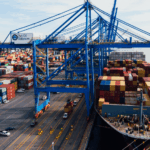Introduction to Climate Resilience in Business
Extreme weather is no longer an outlier—it’s the baseline. Floods, droughts, heatwaves, and wildfires disrupt factories, transport corridors, and consumer prices. The once-celebrated efficiency of “just-in-time” now exposes businesses to cascading climate risks. As I argue in my book, Practical Sustainability Strategies, resilience must move from side project to core strategy.
Recent shocks make this clear: Thai floods that halted global production, drought in the Panama Canal that raised freight costs, and low water levels on the Rhine and Mississippi that slowed raw-material flows. What changed isn’t only severity—it’s frequency. Repeated climate disruptions compound costs and erode resilience.
Benefits of Climate-Resilient Supply Chains
Investing in resilience delivers tangible value:
-
Operational continuity: Fewer shutdowns and shorter delays.
-
Investor confidence: Stronger ESG performance and clearer risk disclosures.
-
Cost control: Reduced exposure to climate-driven inflation.
-
Reputation and trust: Transparent, accountable operations that withstand scrutiny.
Through the Center for Sustainability and Excellence (CSE), we’ve seen organizations convert resilience into competitive advantage by embedding it across procurement, engineering, finance, and board oversight.
Practical Steps, Tools, and Best Practices
1) Map risk beyond Tier 1
Trace critical inputs to Tier 2/3. Know where water, energy, and key components originate—otherwise you’re managing by hope, not evidence.
2) Run climate stress tests
Model floods, droughts, wildfires, and route blockages. Decide where to hold buffer inventory, pre-pay redundancy, and lock alternative routes.
3) Treat water as a strategic input
Add water footprint KPIs alongside energy metrics; what isn’t measured isn’t managed.
4) Diversify suppliers and geographies
Include climate clauses and continuity plans in contracts to spread risk.
5) Design for flexibility
Use modular BOMs and alternate specs so you can swap materials or suppliers without redesigning entire products.
6) Build real-time visibility
Deploy early-warning signals: river levels, weather anomalies, canal/port congestion, and transport capacity—visibility is a lifeline, not a luxury.
7) Close the protection gap
Combine business-interruption coverage with climate bonds and freight hedging to finance shocks efficiently.
Example: Greece as a Resilience Hub (and a Stress Test)
Greece sits at the nexus of shipping, agri-food, tourism, and energy—both vulnerable and vital. Ports like Piraeus and Thessaloniki can set the standard with climate forecasting, backup power, water infrastructure, and cold-chain protection. Agri-food (olive oil, wine, cotton) needs water efficiency, heat-resilient varieties, climate-smart contracts, and shared cold-chain logistics. Shipping can advance not just decarbonization but resilience via green corridors and intelligent routing.
Common Mistakes to Avoid
-
Treating resilience as a one-off project instead of a continuous capability.
-
Focusing only on carbon while ignoring water scarcity and extreme heat.
-
Waiting for regulation instead of building internal readiness now.
Realism Without Fatalism
“Keep production where it is and subsidize after every flood” is not policy—it’s postponement with public money. Yet retreat and self-sufficiency aren’t solutions either; they raise costs and leave us exposed to the next shock. The path forward is smarter globalization: diversified, transparent, and resilient.
At the board level, put climate risk on every agenda—map critical inputs, define Plan B/C, fund resilience KPIs. At the policy level, prioritize truthful pricing, resilient infrastructure, open risk data, and disclosures that lead to real strategies (not box-ticking). Internationally, resist export bans, share stock data, and coordinate calmly. There is no perfectly “safe” supply chain on an unstable planet—but resilient ones are achievable when we face facts and act.
FAQs
What is a climate-resilient supply chain in simple terms?
A supply chain designed to withstand and recover from climate shocks—keeping production and deliveries stable despite floods, droughts, or heatwaves.
How long does it take to build climate resilience?
Typically 12–36 months for mapping, stress tests, design changes, visibility tools, and financial hedges—faster if you already have strong risk processes.
Is climate resilience worth it for career growth?
Yes. Resilience skills are in high demand across operations, procurement, and ESG. Training via the Sustainability Academy helps professionals translate strategy into measurable results.









